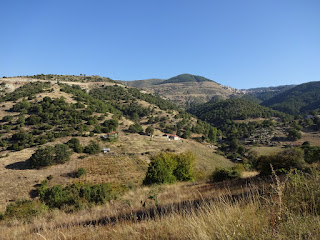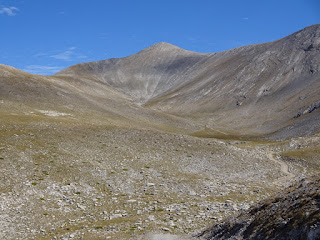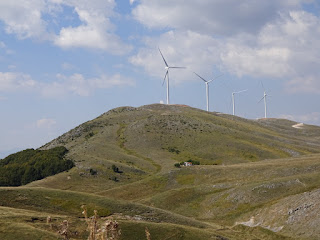Mount Olympus and Meteora are world class sites attracting large volumes of tourists, however the section of the E4 Long Distance European trail between them appears to attract very few visits.
The grandeur of Mount Olympus with its rocky summits means fit people from many countries make the long climb (some 2600 metres from the favoured starting point of Litochoro although many seem to get transport up to Priona reducing the climb to a still substantial 1600 metres). It is an exhilarating and satisfying experience to reach the top, especially of the more difficult peak of Mytikas, and see a large piece of Greece spread out around you. You will have plenty of company on the summits yet coming down the west side of Mount Olympus to Kokkinopelos you could be the only visitor in the village.
Meteora, with its ancient monasteries built on distinctive pillars of rock to escape the distractions of the world are now overwhelmed by coach parties of tourists (or at least those parts near a car park). Most are rather less fit than those who climb Olympus but no less ready to photograph themselves with a stunning background.
In between the two sites a visitor will attract curiosity due to their rarity, although viewing the moon rising over Mount Olympus from the picturesque village of Livadi while enjoying an evening beer is a much richer experience than sitting among the coach parties in Litochoro or Kalampaka.
Despite the difficulties in knowing exactly where the E4 goes, especially after Descati, the walk from Olympus to Meteora was rather more interesting than I anticipated. While I expected farmland I had not realised quite how many hills, woodlands and mountains the route covered. Nor was I expecting villages to be halfway up the mountain side. The downside of no tourists was a lack of accommodation between Livadi and Meteora although with more effort some might be found, fortunately there were more places suitable for wild camping than I expected.
One of the pleasures of long distance walking is visiting places where you would not otherwise plan to go and your trip being enriched by what you find. For this reason missing out the bit between the two famous sites would be a loss to the experience of walking the E4.
The route I took can be downloaded as a gpx file for your GPS from Wikiloc.com or can be accessed with your smartphone using ViewRanger, shortcode johnpon0039. I did not include the route over Mount Olympus from Litochoro to Kokkinopelos, as this can readily be found on various maps and downloads.
Since completing this section my attention was kindly drawn to a German site with a GPS track of the same section of the E4. In places, most significantly between Livadero and Kalampaka, it takes alternative routes to mine, although not necessarily closer to the intended path of the E4 (whatever that is!). I have since bought the Anavasi map of Meteora, which shows that at least I arrived in the area on the "correct" route of the E4.
The grandeur of Mount Olympus with its rocky summits means fit people from many countries make the long climb (some 2600 metres from the favoured starting point of Litochoro although many seem to get transport up to Priona reducing the climb to a still substantial 1600 metres). It is an exhilarating and satisfying experience to reach the top, especially of the more difficult peak of Mytikas, and see a large piece of Greece spread out around you. You will have plenty of company on the summits yet coming down the west side of Mount Olympus to Kokkinopelos you could be the only visitor in the village.
Meteora, with its ancient monasteries built on distinctive pillars of rock to escape the distractions of the world are now overwhelmed by coach parties of tourists (or at least those parts near a car park). Most are rather less fit than those who climb Olympus but no less ready to photograph themselves with a stunning background.
In between the two sites a visitor will attract curiosity due to their rarity, although viewing the moon rising over Mount Olympus from the picturesque village of Livadi while enjoying an evening beer is a much richer experience than sitting among the coach parties in Litochoro or Kalampaka.
Despite the difficulties in knowing exactly where the E4 goes, especially after Descati, the walk from Olympus to Meteora was rather more interesting than I anticipated. While I expected farmland I had not realised quite how many hills, woodlands and mountains the route covered. Nor was I expecting villages to be halfway up the mountain side. The downside of no tourists was a lack of accommodation between Livadi and Meteora although with more effort some might be found, fortunately there were more places suitable for wild camping than I expected.
One of the pleasures of long distance walking is visiting places where you would not otherwise plan to go and your trip being enriched by what you find. For this reason missing out the bit between the two famous sites would be a loss to the experience of walking the E4.
The route I took can be downloaded as a gpx file for your GPS from Wikiloc.com or can be accessed with your smartphone using ViewRanger, shortcode johnpon0039. I did not include the route over Mount Olympus from Litochoro to Kokkinopelos, as this can readily be found on various maps and downloads.
Since completing this section my attention was kindly drawn to a German site with a GPS track of the same section of the E4. In places, most significantly between Livadero and Kalampaka, it takes alternative routes to mine, although not necessarily closer to the intended path of the E4 (whatever that is!). I have since bought the Anavasi map of Meteora, which shows that at least I arrived in the area on the "correct" route of the E4.
 |
| Sun rise over Mount Olympus viewed from Livadi |





































